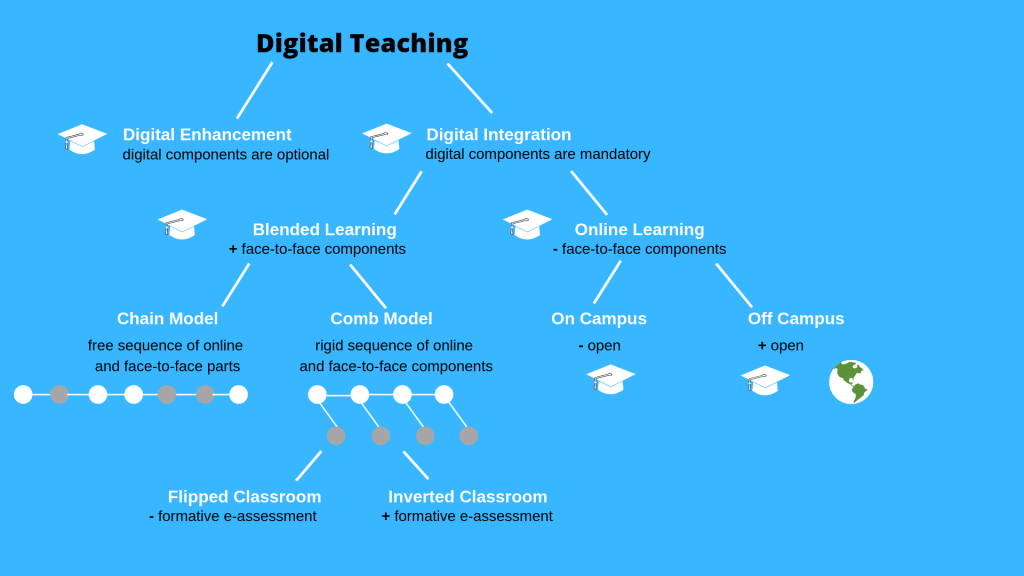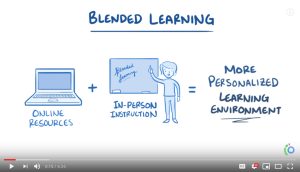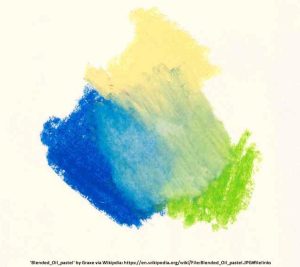Blended Learning
Definition
All teaching scenarios that are not exclusively delivered face-to-face or online can be summarized under the umbrella term ‘Blended’ or ‘Hybrid Learning’, which thus means a deliberate combination of digital content and/ or activities with in-class instruction. Viewed on a spectrum, blended learning takes a position in between digitally enhanced in-classroom instruction and fully online delivery. Many educators make deliberate decisions which portions of face-to-face instruction to replace with online components as to “find […] a harmonious balance between online access to knowledge and face-to-face human interaction” (Osguthorpe & Graham, 2003).

Why Blend?
The majority of reasons why educators choose to blend their courses revolves around accessibility, pedagogical effectiveness and course interaction.
Replacing specific in-class components with online materials and activities increases the flexibility with which students can engage with the course content, the instructor and their peers in- and outside of the classroom. When surveyed on their blended learning experiences, students often like the ability to conveniently access course materials anytime and anyplace. For many students, online resources are an ideal way to offset missed classes or improve understanding of course content through self-paced reviews.
For many instructors on the other hand, the motivation behind the design of blended learning experiences is the potential increase in teacher and student interaction. Instead of dedicating class time to lectures or extended explanations, students get opportunities to connect with the content and their peers through class discussions and a variety of practice activities. Many instructors find that the enhanced teacher and student interaction often leads to an overall improvement in student engagement and performance (Aycock et al., 2002; Dziuban & Moskal, 2001; Garnham & Kaleta, 2002).
Research supports the contention that student satisfaction and achievements seem to be higher in blended courses as compared to traditional face-to-face and fully online courses (Means, Toyama, Murphy, Bakia & Jones, 2009) for the abovementioned reasons.

How to Blend?
How many of the face-to-face components are replaced with online instruction varies widely depending on course instructional goals, student characteristics, instructor experience and teaching style, discipline, developmental level, and online resources. New learning technologies as for instance podcasting, internet-based audio and video communication, e-portfolios, web-annotation and social networking tools including blogs, websites and wikis create new blending potentials. Littlejohn and Pegler (2006) classify ‘strong’ and ‘weak’ blends to describe the continuum across big to small components of online learning.
There is no unified approach as to how to best blend each of the three different learning approaches below:
- Autonomous Online-Learning: The students can decide when, how often and where they want to do the digitally available tasks and activities.
- Synchronous Online Learning: Students either attend virtually hosted lectures (webcasts) or do academic activities in an online learning environment synchronously at a set time (live chat, video conference, etc.). This allows learners to interact with their peers and instructor in real time.
- The traditional in-class instruction takes place in a lecture hall, lab or seminar room, where students and educators interact with each other face to face at set times throughout an academic term.
While there is no agreement how much or how little digital engagement should be included in the blend, however, many researchers agree that sound pedagogical planning is more important than a singular focus on the percentage of online instruction to create well-paced cyclical and coherent learning experiences for the students (Dziuban, Moskal & Hartman, 2005). Arnold, Kilian, Thillosen, & Zimmer (2011) recommend staging the learning processes effectively and to also include a variety in interaction patterns. In the end, course objectives should be matched with appropriate teaching methods.
“The emphasis is on pedagogy not technology. Ask yourself what isn’t working in your course that can be done differently or better online.” (Garnham & Kaleta, 2002)
Types of Blended Learning
Clayton M. Christensen, Michael B. Horn und Heather Stalker (2013) define 4 models, in which online and face-to-face instruction are combined differently:
Rotation-Model: The teacher plans how and when students rotate between different learning modalities (at least one of which is online) within a course or subject. There are four Rotation submodels, namely the Station Rotation Model, the Lab Rotation Model, the Flipped Classroom Model and the Individual Rotation Model.
Flex-Model: Online Learning is the backbone of student learning here. Materials are provided for students to move on a fluid schedule among learning modalities. The instructor can be contacted for help and will also provide face-to-face support.
A la Carte Model or Self-blend Model: Students decide for themselves, if they want to supplement their regular courses with online offerings at other institutions.
Enriched-Virtual model: An online course contains face-to-face components that enhance the learning experience, such as at the beginning or the conclusion of an online course.
What does it take to implement Blended Learning?
A few key challenges need to be addressed order for students to succeed in blended learning courses. It is crucial that the instructor speaks to intentions behind the approach at the beginning of term. Students also need to be made aware of what the requirements from them are with regard to time management, the responsibility for personal learning and the technologies in use.
From a faculty perspective, the key challenges of teaching in a blended format are: (a) the time commitment, (b) lack of support for course redesign, (c) difficulty in acquiring new teaching and technology skills, and (d) the risk factors associated with this type of course (Voos, 2003; Dziuban & Moskal, 2001; Garnham & Kaleta, 2002).

References:
Allen, E., & Seaman, J. (2011). Going the distance: Online education in the United States, 2011. The Sloan Consortium. Needham, MA: Sloan-C. Retrieved December 3, 2018 from https://files.eric.ed.gov/fulltext/ED529948.pdf
Arnold, P., Kilian, L., Thillosen, A. & Zimmer, G. (2011): Handbuch E-Learning – Lehren und Lernen mit digitalen Medien (2. erw., akt. u. vollst. überarb. Aufl.): Bielefeld: W. Bertelsmann Verlag.
Aycock, A., Garnham, C., & Kaleta, R. (2002). Lessons learned from the hybrid course project. Teaching with Technology Today, 8(6). Retrieved December 4, 2018 from https://hccelearning.files.wordpress.com/2010/09/lessons-learned-from-the-hybrid-course-project.pdf
Bates, T., & Poole, G. (2003). Effective teaching with technology in higher education: Foundations for success. San Francisco: Jossey-Bass.
Bleed, R. (2001). A hybrid campus for a new millennium. Educause Review, 36(1), 16-24. https://www.learntechlib.org/j/IJEL/v/15/n/2/
Blended Learning Toolkit (2012). Retrieved December1, 2018 from https://blended.online.ucf.edu
Christensen, Clayton M.; Horn, Michael B. & Staker, Heather (2013): Is K-12 Blended Learning Disruptive? An introduction to the theory of hybrids. Retrieved on November 30, 2018 from https://www.christenseninstitute.org/publications/hybrids/
Dziuban, C., Hartman, J., Cavanagh, T., & Moskal, P. (2011). Blended courses as drivers of institutional transformation. In A. Kitchenham (Ed.), Blended learning across disciplines: Models for implementation. Hershey, PA: IGI Global.
Dziuban, C. D., & Moskal, P. D. (2011). A course is a course is a course: Factor invariance in student evaluation of online, blended and face-to-face learning environments. Internet and Higher Education, 14, 236–241. Retrieved December 1, 2018 from https://www2.fgcu.edu/FacultySenate/files/2-8-2013_Charles_Dziuban_-_A_Course_Is_A_Course.pdf
Dziuban, C. D., Moskal, P. D., Bradford, G. R., Brophy-Ellison, J., & Groff, A. T. (2010). Constructs that impact the net generation’s satisfaction with online learning. In R. Sharpe, H. Beetham, & De Freitas (Eds.), Rethinking learning for a digital age: How learners are shaping their own experiences. New York, NY: Routledge.
Dziuban, C.D., Moskal, P.D., Hartman, J. (2005): Higher education, blended learning, and the generations: Knowledge is power: No more: In J. Bourne & J.C. Moore (Eds.), Elements of Quality Online Education: Engaging Communities. Needham: MA: Sloan Center for Online Education. Retrieved on November 30, 2018 from http://desarrollodocente.uc.cl/images/Innovación/Flipped/Knowledge_is_power_no_more.pdf
eScouts. Inverted Classroom. Open Moodle Course and Blog from the Ruhr Uni Bochum/ Germany. Accessible at https://www.rubel.rub.de/escouts/inverted-classroom
Garnham, C., & Kaleta, R. (2002). Introduction to hybrid courses. Teaching with Technology Today, 8(6). Retrieved October 3, 2006, from http://www.uwsa.edu/ttt/articles/garnham.html
Garrison, D.R. & Kanuka, H. (2004). Blended learning: Uncovering its transformative potential in higher education. The Internet and Higher Education, 7, Retrieved December 1, 2018 from https://www.learntechlib.org/p/102559/
Handke, J. (November, 2018). A professor for Linguistics and Language Technology at Uni Marburg/ Germany moderates a broadcast on the Digitalization in Higher Education. As part of 20 Themen – 20 Köpfe – Digitalisierung in der Hochschullehre https://www.deutschlandfunk.de/reihe-20-themen-20-koepfe-digitalisierung-in-der.680.de.html?dram:article_id=433875
Handke, J. (2015). Digitalisierung der Hochschullehre. Welche Rolle spielt das Inverted Classroom Model dabei?. In Johann Haag, Josef Weißenböck, Wolfgang Gruber und Christian F. Freisleben-Teutscher (Hrsg.), Neue Technologien – Kollaboration – Personalisierung. Beiträge zum 3. Tag der Lehre an der FH St. Pölten am 16. Oktober 2014. St.Pölten, D: Fachhochschule St. Pölten. Retrieved December4, 2018 from https://moodle.ruhr-uni-bochum.de/m/pluginfile.php/290442/mod_resource/content/3/Handke_Rolle%20des%20ICM%20in%20der%20Digitalisierung%20der%20Hochschullehre.pdf
Littlejohn, A., & Pegler, C. (2007). Preparing for Blended e-Learning. London: Routledge.
Means, B., Toyama, Y., Murphy, R., Bakia, M., & Jones, K. (2009). Evaluation of evidence-based practices in online learning: A meta-analysis and review of online learning studies. Washington, D.C.: U.S. Department of Education, Office of Planning, Evaluation, and Policy Development.
Moskal, P., Dziuban, C. & Hartman, J. (2013). Blended Learning: A dangerous idea? The Internet and Higher Education 18, 15-23. Retrieved December 1, 2018 from http://www.uws.edu.au/__data/assets/pdf_file/0020/530336/Reading7_BlendedLearning-ADangerousIdea.pdf
Osguthorpe, R.T. & Graham, C.R. (2003). Blended learning environments, definitions and directions. The Quarterly Review of Distance Education, 4(3), 227233. Retrieved December 1, 2018 from https://www.learntechlib.org/p/97576/
Schön, S., Ebner, M., Schön, M. (2016). Verschmelzung von digitalen und analogen Lehr – und Lernformaten. Arbeitspapier Nr. 25. Berlin: Hochschulforum Digitalisierung. CC-BY-SA. Retrieved September 2018, from https://hochschulforumdigitalisierung.de/sites/default/files/dateien/HFD_AP_Nr25_Verschmelzung_Digitale_Analoge_Lernformate.pdf
Sharpe, R., Benfield, G., Roberts, G., & Francis, R. (2006). The undergraduate experience of blended learning: A review of UK literature and practice. Retrieved 1 June, 2008 from http://www.heacademy.ac.uk/projects/detail/lr_2006_sharpe
Sommer, J. & Handke, J. Blended Learning in Großgruppen. Online Module with Moderation (26.11.-09.12.2018) Accessible at https://www.e-teaching.org/praxis/themenspecials/learning-e-learning/themeneinheiten/blended-learning-in-grossgruppen?fbclid=IwAR3HPBDHP63wrkH2lxASiLWzr4-DJ7VcMS3jl3ezUZY9sgpjULErlC_HeGI
Stacey, E., & Gerbic, P. (2007). Teaching for blended learning – Research perspectives from on-campus and distance students. Educational and Information Technologies, 12(3), 165-174.
Stacey, E., Smith, P.J. & Barty, K. (2004). Adult learners in the workplace: Online learning and communities of practice. Distance Education, 25(1), 107-124.
Stacey, E., & Gerbic, P. (2008). Success factors for blended learning. In Hello! Where are you in the landscape of educational technology? Proceedings ascilite Melbourne Retrieved December 4, 2018 from http://www.ascilite.org/conferences/melbourne08/procs/stacey.pdf
Vaughan, N. (2007): Perspectives on Blended Learning in Higher Education: International Journal on E-Learning. 6 (1), pp. 81-94. Chesapeake, VA: AACE. Retrieved December 3, 2018 from https://www.learntechlib.org/primary/p/48048/


